Guitar Hero World Tour
- View history
Guitar Hero World Tour (initially referred to as Guitar Hero IV or Guitar Hero IV: World Tour ) is a music video game developed by Neversoft and published by RedOctane and Activision. It is the fourth main entry in the Guitar Hero series . The game was launched in North America in October 26, 2008 for the PlayStation 2 , PlayStation 3 , Wii , and Xbox 360 consoles, and a month later for Europe and Australia. A version of Guitar Hero World Tour for Microsoft Windows and Apple Macintosh has also been announced for a release on July 26, 2009 and was the last Guitar Hero game published to these operating systems by Aspyr Media.
While the game continues to feature the use of a guitar-shaped controller to simulate the playing of rock music, Guitar Hero World Tour is the first game in the Guitar Hero series to feature drum and microphone controllers for percussion and vocal parts, similar in manner to the competing Rock Band series of games. The game allows users to create new songs through the " Music Studio " mode, which can then be uploaded and shared through a service known as " GHTunes ".
World Tour received generally positive reviews with critics responding positively to the quality of the instrument controllers, the customization abilities, and improvements in the game's difficulty compared with the previous Guitar Hero III: Legends of Rock . Some reviewers have commented on issues with poorly laid-out note tracks, the limited Career modes, and the difficulty of the music creation tool and the poor quality of the resulting songs.
- 1.1 Bundling and promotion
- 2.1 Games Modes
- 2.2 Characters and Customization
- 2.3.1 Guitar
- 2.3.2 Drumkit
- 2.3.3 Microphone
- 2.3.4 Instrument compatibility
- 3.1 Custom songs
- 4 References

Development
The fourth major entry to the Guitar Hero series, referred to as Guitar Hero IV at the time, was officially announced upon the merger of Activision and Vivendi Games in December 2007. "We couldn't have done it without Red Octane's support." says the Guitar Hero Team. [1] The game's new title, Guitar Hero World Tour , was officially announced by Activision in May 2008. [2]
Activision and RedOctane had previously registered for trademarks on " Guitar Villain ", " Drum Villain ", " Keyboard Hero ", " Drum Hero " and " Band Hero " [3] (the latter being used in a later title ). Analysts theorized that future Guitar Hero would need to include additional instrument peripherals in order to compete against the former Guitar Hero developer Harmonix 's Rock Band . [4] Activision's CEO Bobby Kotick and early previews of the game revealed that Guitar Hero IV would branch out into other instruments and vocals. [5] [6] [7]
According to the Game Informer preview, the addition of drum functionality came from work initially done towards the Drum Hero title. This work was later folded into the Guitar Hero series after Neversoft was chosen as developer of the series. [5] Neversoft's Allen Flores stated that with the addition of the existing drum gameplay, the development of World Tour took under a year, starting development immediately after the release of Guitar Hero III: Legends of Rock . [8] The drum instrument controller was designed to be more realistic, with details from Chad Smith of Red Hot Chili Peppers , Stewart Copeland of The Police , and Travis Barker of Blink-182 , all of whom requested the elevated cymbal pads. [8] The ability to open-strum the guitar was a feature that was planned for Guitar Hero III: Legends of Rock but was removed before release, finding that it was too difficult on the Guitar tracks. However, they built this feature in from the start of World Tour development exclusively for the Bass tracks. [9]
Bright describes the development of the note track for a given song once it has been licensed for the game as a parallel effort, a process that they have found to be more efficient than their previous work on the Tony Hawk games. [9] Once the song was mixed for use by the development team, a "tempo map" was created by one developer; this map denotes the beats in the music which then can be used by the rest of the development team. Once the tempo map was complete, the song was then distributed to the various teams, such as the specific instrument teams or to the animators, to complete the song. [9] Note-for-note tracking from the song was then performed, and in some cases, changes were made to account for sections that cannot be replicated on the game controllers; the final track represented the note track for the Expert difficulty of the song. Note tracks were then reduced and adjusted to create the note tracks for the lower difficulties in the game. [9] A difficulty assessment was made using the final note tracks to determine where the songs were to be placed in the soundtrack progression. The difficulty model is based on that from Guitar Hero: Aerosmith , which was adjusted from the Guitar Hero III model after the team received negative feedback from players regarding a "brick wall" in the difficulty progression in that game. [9]
The song list for World Tour started as the list of songs that Neversoft wanted to include in Guitar Hero III , but had failed to get into the game or as downloadable content; the list was eventually expanded to over 500 songs. [9] The song list was then prioritized based on what the team thought would be best in the game, and then going after the music that would take the longest time to license, as was the case for the Jimi Hendrix songs. [9] While songs were selected to make sure that guitar, bass, and drums all had great parts, they also opted for songs that would be strong for one single instrument as to make the game still appealing for those playing the single player modes. [9] Some songs were also suggested through the licensing efforts by Activision for inclusion in the game. [9] Flores stated that the inclusion of caricatures of recording artists in the game was either due to the team seeking that specific artist for the game, or the artist approaching the development team and requesting to be part of it. [8] The band Tool , which hasn't licensed its music since 1996, allowed for the inclusion of three of its songs in World Tour as long they were involved with the artwork and tracking of the songs for the game, leading to the creation of the art-like Tool venue. [10]
Bright noted that they had support for "epic drum solos", in which the band animation would focus on the drummer, but removed this feature from the game's final release due to its complexity. [9] They also had to remove the "Jam Over" mode planned for the game's music creation section that would have allowed players to start with one of the game's songs and play over it on their instruments; this feature was removed in order to keep the final product polished and on-time. [9]
The custom song creation feature was inspired by the current "hacking environment" that has arisen from the first two Guitar Hero games, where players would create new tracks and share them with others. [11] [12]
Meanwhile Hands-On Mobile acquired to create a mobile phone version of the game to be released later in November 2008. [13]
A port of Guitar Hero World Tour has been rated by the ESRB for Microsoft Windows computers , though Activision has not officially confirmed this version [14] until it was confirmed by Intel on February 27, 2009 [15] and displayed at CeBIT on March 3–8, 2009 in Hannover, Germany. [16] [17] [18]
Bundling and promotion
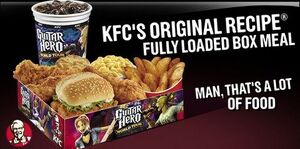
KFC's Guitar Hero -branded Fully Loaded Box Meal.
In preparation for the release of Guitar Hero World Tour , Activision partnered with the fast-food chain company Kentucky Fried Chicken to promote the upcoming release of Guitar Hero World Tour in their Fully Loaded Box Meals in September 2008, [19] which consisted "KFC snacker" sandwich, two chicken strips, a drumstick or thigh, a biscuit, two sides and a 32 ounce soft drink. On October 28, 2008, Kotaku gave their impression of the KFC promotion, giving their overall rating the selection of food with a D-, stating that "it was one of the few meals where vomit phobia was almost outweighed by a feeling to purge this poison." [20]
On October 26, 2008, Guitar Hero World Tour was released in North America with several bundle packages, as well as a standalone game. Europe and Australia received this title in November 2008. In addition to a game bundle that includes a wireless guitar for each platform, the game can be bought in one of two bundles that include the guitar, drums, and microphone controller. The second bundle, only available through RedOctane's store, also includes a T-shirt, keychain, and a recharging kit. [21] Players in the United Kingdom who pre-order the full band bundle also received a second guitar controller for bass players. The bass guitar is the Les Paul guitar, the same model as bundled with Guitar Hero III: Legends of Rock . [22] During the Christmas season of 2008, Some retailers, such as Target, sold in-store a dual guitar bundle which included two identical wireless Les Paul styled guitars from previous game versions and did not include the new guitar with the tapping area.
Activision created a series of television advertisements directed by Brett Ratner based on the famous scene from Risky Business where Tom Cruise dances to Bob Seger 's " Old Time Rock and Roll " in a shirt and underwear, each featuring a different set of celebrities lip synching to the lyrics while using the new instrument controllers. The first ad included athletes Kobe Bryant, Tony Hawk, Alex Rodriguez, and Michael Phelps. [23] Another ad spot featured model Heidi Klum; two versions of Klum's ad exist, one a "director's cut" where she is wearing less clothing. [24] A subsequent commercial featuring model Marisa Miller was banned from airing as too racy. [25] [26]
A viral YouTube video titled "Bike Hero" showed what appeared to be a teenager riding a bike along a route marked with symbols similar in appearance to the in-game note tracks with LED lights on the handlebars blinking in time to the notes to the song " Prisoner of Society " by The Living End . The video was later determined to be the work of a viral marketing company Droga5 in cooperation with Activision to promote the Guitar Hero games. [27] The viral advertisement was considered a success, with about 3.5 million views since its release. [28]
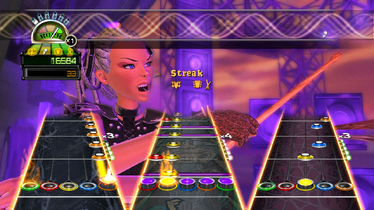
Gameplay of a whole band playing Billy Idol's "Rebel Yell". On top is vocalist, bottom from left to right: Guitar, Drums, Bass
Guitar Hero World Tour builds on the gameplay from previous Guitar Hero games, in which players attempt to simulate the playing of rock music using special guitar-shaped controllers. World Tour expands beyond the core guitar-based gameplay by introducing the ability to play drums and sing vocals, and supports the ability for up to four players to play together in a virtual band through these different instruments. Successfully hitting notes increases the player's or band's score, as well as increase the " Rock Meter " that represents the song's performance. Missed notes are not scored and negatively affect the Rock Meter. If the Rock Meter drops too low, the song ends prematurely, with the virtual audience booing the band off stage. Completing a consecutive series of notes successfully will increase a scoring multiplier for that player up to 4x. This multiplier is doubled when the player activates star power. Similar to Rock Band, the band shares a common score, scoring multiplier and band performance meter while each player has their own performance metric; the band also shares the same " Star Power " meter, though any player may activate it at any time. A player that performs poorly and reduces their performance meter to zero can still continue to play, but they drain the overall performance meter for the band, requiring the other players to make up for this. Successfully completing a song garners a three to five-star rating based on the accumulated score, and rewards such as in-game money that can be used to buy new guitars and outfits for characters.
The guitar interface remains relatively unchanged in World Tour . As with previous Guitar Hero titles, the guitar and bass player must hold down the correct fret button(s) on the controller while strumming in time with the notes as they scroll on-screen. One addition to the guitar gameplay is the ability to play notes while holding a sustained note. Additionally, the bass guitar player will be required to play notes representing an open E/Fb string, which is shown on-screen as a solid line across their note track. To play these notes, the bass guitar player strums the controller without pressing any fret button keys. The drum interface is similar to the guitar's interface, with each on-screen note track equivalent to a colored drum head on the controller, with the bass drum indicated by a line across the note track. The drum player only needs to hit the correct drum pads simultaneously to the note gems to successfully play their track. There are also marked sections on the drum part wherein the player may play any notes they wish in a 'solo' to gain points. The vocal track requires the player to match the pitch of the notes in a manner similar to Karaoke Revolution to be successful. Special sections of each players' note track are marked with glowing notes, which, if completed successfully, builds up Star Power. Once enough Star Power is accumulated, it can be released via various means to double the band's current score multiplier. For guitar and bass, this is done by lifting the guitar controller vertically or (though not in bass) by pressing a button on the guitar face; for drums, by striking both cymbal pads on the controller at the same time; for vocals, by tapping the microphone or making a similarly quick sound.
In addition to the standard four difficulty levels ( Easy , Medium , Hard , and Expert ) for each song and instrument, a new Beginner level has been added in World Tour. This difficulty is aimed for younger and unskilled players; notes are generally simple straight lines in time with bass drum beats, and allowing any or no fret button to be held while the note is strummed (for lead and bass guitar), any drum to be hit (for drums), or any sound to be made (for vocals).
Games Modes
The primary single-player game mode is Career mode, which can be played on either the lead guitar, bass guitar, drums, or vocals. Career mode has been slightly altered from previous Guitar Hero games. After creating a band, selecting or creating an avatar, and then selecting an instrument, the player is then presented with one of several gigs containing two to five songs each. Most gigs end with an encore song that is not revealed until the other songs are completed. Two of the lead guitar gigs feature "boss challenges" with Zakk Wylde and Ted Nugent; these boss challenges, featuring original songs by Wylde and Nugent, are different from Guitar Hero III 's boss battle, removing the focus on attack power-ups and instead featuring a call-and-response mechanic similar to the existing Face-Off mode. The gigs are arranged by difficulty based on the selected instrument. The player is awarded in-game money for each song completed, and completing each gig can also award additional money for meeting certain criteria, such as never letting the Rock Meter drop below a certain level or playing the first several notes of a song perfectly. Completing a gig can also unlock one or more gigs with more difficult songs to complete. Additional awards, such as customization items, are also awarded for completing gigs. The player's accumulated earnings across any of the single player Career Modes are tracked and used to rank the player's overall performance level.
Band Career mode is similar to the solo Career mode, with the game songs presented as several gigs to be completed. A band must have at least two players to proceed, but the second player may be either a local player or one over the network. Players may be at different levels of progression in the game, but will still gain benefits for successfully completing songs when playing together. After completing each gig, a magazine will appear on screen with the band featured on the cover.
The in-game interface features vocals along the top of the screen, and three tracks underneath, for bass, drums, and guitar; only tracks for active players will be shown. Full four-player bands can compete with other bands online in a Battle of the Bands mode.
Both single players and bands can play a setlist of up to six songs in Quickplay mode, still earning in-game money rewards for their performances. Existing competitive modes from the series, including the Battle Mode from Guitar Hero III , are also present in the game.
The Wii version of the game features a special " Mii Freestyle " mode that allows players to use their Miis as their characters as they improvise songs via the guitar and drum controllers or using the Wii Remote and Nunchuk.
Characters and Customization
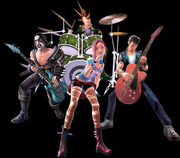
Render of a band composed of in-game characters: Judy Nails on vocals, Eddie Knox on guitar, Lars Umlaut on bass and Johnny Napalm on drums.
Players are able to use the Create-a-Rocker mode which is based on the Create-a-Skater mode in Neversoft's Tony Hawk series and the advanced character creation scheme from the Tiger Woods PGA Tour series. Players can change their character's pose, clothing, tattoos, makeup, and age. Selected characters from previous Guitar Hero games are available as templates for creating a rocker. Previous games featured Gibson Guitars, but as a result of a lawsuit with Gibson Guitars, branded guitars are not featured; instead, the player can create a customized guitar from various components, such as bodies, fretboards, and headstocks. The player's in-game drum set and microphone can also be similarly customized. Activision had formed partnerships with several instrument equipment manufactures to featured in the game, including Ampeg, Audio-Technica, EMG Pickups, Ernie Ball, Evans Drumheads, Guitar Center, Krank Amplification, Mackie, Marshall, Orange County Drum & Percussion, Pork Pie Percussion, Regal Tip, Sabian, Vox, and Zildjian.
In addition to the computer- and player-controlled characters, avatars of notable musicians are featured in the game, either with motion capture or the licensing of their image for their character. Such artists include Hayley Williams , Jimi Hendrix , Ozzy Osbourne , Zakk Wylde , Billy Corgan , Sting , Ted Nugent , and Travis Barker .
New venues in the game include virtual recreations of real arenas, such as Ozzfest , Amoeba Music , Live Nation’s House of Blues , Sunset Strip and San Francisco’s AT&T Park . One venue showcases the trademark art style of Tool and was developed in collaboration with the band. World Tour is the first Activision game on the PlayStation 3 to support dynamic in-game advertising provided by IGA Worldwide; similar advertising for the Xbox 360 version is provided by Massive Incorporated.
Instruments

Guitar Hero World Tour Wireless Guitar Controller
RedOctane developed a new guitar controller for World Tour . The unit is approximately 25% (1/4) larger than previous controllers, making it closer to the size of a real guitar. The new controller includes a longer whammy bar and places the Star Power button directly below the strum bar, improving the access of these features. The strum bar itself was made quieter and longer. The neck of the guitar is detachable, similar to the Gibson Les Paul controller for Guitar Hero III: Legends of Rock , but the connector has been hardened to avoid connection issues experienced with the previous unit.
The neck of the guitar features a touch-sensitive pad just below the normal five fret buttons. The player can use either the fret buttons or the touch pad to play regular notes. The pad also allows the player to play notes via tapping or via " tap strumming " similar to the slap bass method for bass guitar, and to alter the pitch of sustained notes. Guitar tracks feature notes connected by a semi-transparent purple line, (except for the Wii version, in which semi-transparent gems replace this purple line) called " Slider Gems "; the player can play these notes by sliding their fingers up and down the touch pad or by tapping the fret buttons without strumming. The touchpad can also be used for sustained and staccato notes in the music studio feature while recording guitar, and is used for finer control over loops when recording other instruments.
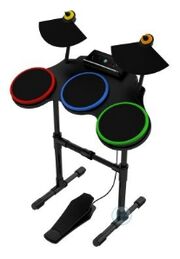
Guitar Hero World Tour Wireless Drum Controller . It includes 3 drum pads, 2 cymbal pads, and a bass drum pedal.
Guitar Hero World Tour features a wireless six-piece drum kit, with a bass drum pedal and five velocity-sensitive drum pads for snare (red), two toms (green and blue), and two cymbals (yellow and orange), which Activision has stated provide the " most realistic drum experience ever in a video game ". The drum kit was designed with help from John Devacka, the developer of MTV Drumscape, and developed key patents used for most modern music games that are now owned by Activision. Special note gems on the drum track are " armored ", requiring the player to strike harder on the appropriate drum head in order to break the armor and score points. During song creation, the velocity sensitivity feature of the drum pad allows players to alter the sounds made by the drums. The drum set also has a MIDI input port in the back, allowing users to connect a compatible MIDI drum kit to play in the game. The Wii version of the drum controller includes a slot for the Wii Remote to fit into, enabling it to become wireless, much like the guitar controller introduced for the Wii version of Guitar Hero III: Legends of Rock .
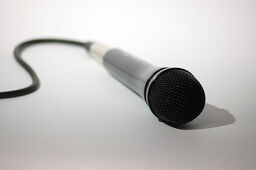
The official microphone used for vocals uses a USB connection. When playing vocals, a gamepad or Wii Remote is necessary in order to navigate menus, select difficulties, and pause.
Logitech and Activision announced that the former company will produce " premium " instruments to be released later in 2008.
Instrument compatibility
World Tour will work with older Guitar Hero guitar controllers. Activision stated during their E3 2008 press conference that Xbox 360 users will be able to use the existing Rock Band instrument controllers as well as other third party controllers in Guitar Hero World Tour; Rock Band instruments for the PlayStation 3 are not guaranteed to work in World Tour, though Sony is attempting to help make these units compatible. All Rock Band original Harmonix instruments for PlayStation 2 will work with World Tour. According to issue 027 of the UK's Official Playstation Magazine, all Guitar Hero and Rock Band PS3 controllers are cross-compatible with all games (except for Guitar Hero: World Tour drums on Rock Band, however some require patching, which is done automatically when connected to the internet).
Console makers have helped to ensure instrument compatibility between current and upcoming guitar and band games. Both Sony and Microsoft have announced that instruments for World Tour , Rock Band 2 , and Konami's Rock Revolution will work between all three games on the PlayStation 3 and Xbox 360. The Wii version of the game only supports guitar controllers from previous Guitar Hero games, and " no compatibility with any other peripherals ". The Rock Band 2 Drums however, are compatible with Guitar Hero World Tour .
World Tour adjusts the tracks in the game to account for the instrument controller being used. For example, sections of the lead guitar track that are designed to be played on the new World Tour controller's touchpad can be played by tapping the frets on older controllers without strumming. When using Rock Band 's drum controller, which has one fewer percussion pad than the World Tour unit and lacks velocity sensitivity, two of the lanes on the " World Tour " drum board merge, reducing the note track to four drum pads and bass pedal, and no armored notes are presented.
All of the 86 songs in the game are master recordings, a first for the series. Project director Brian Bright claims that they have " a pretty even split between the '80s, '90s, and classic rock " with a " good amount of emerging bands ".
Custom songs
Guitar Hero World Tour allows players to create their own songs through Music Studio and share them with others through the Xbox Live, PlayStation Network, and Nintendo Wi-Fi Connection internet capabilities. The Studio is similar to Apple's GarageBand software. The player can create the tracks for each song by playing it in real or slowed time, with the game quantizing offbeat notes to the nearest beat as set by the player, or tracks can be constructed one note at a time. The notes played by the user will be the default Expert difficulty track, and the lower difficulty versions will be generated by the game.
Players can create the tracks for lead, rhythm, and bass guitars and for drums, selecting from a number of different sounds and kits for each instrument. Distortion and other effects can be added to these tracks through Line 6 amplifiers in the " GHMix " mode. Players cannot record vocals directly, but can create a hum-along vocal line in the Studio. PlayStation 3 users with MIDI-compatible computers will also be able to connect their computer to the console and use it for song composition; a similar feature is sought for Xbox 360 owners. Eurogamer reported that a crew at Activision was able to successfully create a " perfectly respectable cover " version of the first verse of " Smells Like Teen Spirit " by Nirvana.
- Phi Psi Kappa (USA)
- Wilted Orchid (Sweden)
- Bone Church (Poland)
- Pang Tang Bay (Hong Kong)
- Amoeba Records (Los Angeles)
- Swamp Shack (Louisiana)
- Rock Brigade (The Pacific)
- Strutter's Farm (Kentucky)
- House of Blues (Los Angeles)
- Ted's Tiki Hut (Tahiti)
- Will Heilm's Keep (England)
- Recording Studio (Canada)
- AT&T Park (San Francisco)
- Tesla's Coil (Australia)
- Ozzfest (Germany)
- Times Square (New York City)
- Sunna's Chariot (Asgard)
- ↑ Elliot, Phil (2007-12-03). " Activision Blizzard fact sheet reveals some unannounced titles in the pipeline ". Game Industry Biz . http://www.gamesindustry.biz/content_page.php?aid=31168 .
- ↑ Minkley, Johnny (2008-05-21). " Guitar Hero World Tour revealed " . http://www.eurogamer.net/article.php?article_id=141762 .
- ↑ Sinclair, Brendan (2007-01-17). " Activision calls dibs on Guitar Villain, Drum Villain " . http://www.gamespot.com/news/6164293.html .
- ↑ Boyer, Brandon (2007-08-01). " Janco: Guitar Hero To Add New Instruments In 2008 " . http://www.gamasutra.com/php-bin/news_index.php?story=14930 .
- ↑ 5.0 5.1 Template:Cite magazine
- ↑ Hatfield, Daemon (2008-04-21). " Guitar Hero IV Branching Out " . http://uk.wii.ign.com/articles/868/868193p1.html .
- ↑ Faylor, Chris (2008-05-12). " Guitar Hero 4 Includes Song Creation and Sharing, Multiple Instruments, Van Halen, Linkin Park ". Shacknews . http://www.shacknews.com/onearticle.x/52650 .
- ↑ 8.0 8.1 8.2 " Neversoft's Alan Flores Interview ". Team Xbox. 2008-09-17 . http://interviews.teamxbox.com/xbox/2304/Neversofts-Alan-Flores-Interview/p1/ .
- ↑ 9.00 9.01 9.02 9.03 9.04 9.05 9.06 9.07 9.08 9.09 9.10 Chick, Tom (2008-09-25). " Guitar Hero World Tour Developer Interview " . http://www.1up.com/do/previewPage?pager.offset=0&cId=3170171&p= .
- ↑ Template:Cite magazine
- ↑ Pigna, Kris (2008-05-21). " New Details on Guitar Hero World Tour " . http://www.1up.com/do/newsStory?cId=3167919 .
- ↑ Minkley, Johnny (2008-05-21). " Neversoft talks World Tour " . http://www.eurogamer.net/article.php?article_id=141770 .
- ↑ Dredge, Stuart (2008-09-10). " Guitar Hero World Tour coming to mobile phones ". Pocket Gamer . http://www.pocketgamer.co.uk/r/Mobile/Guitar+Hero:+World+Tour/news.asp?c=8837 .
- ↑ Linde, Aaron (2008-07-31). " Guitar Hero World Tour PC Edition Listed by ESRB; Logitech to Offer 'Premium' Instrument Controllers ". Shacknews . http://www.shacknews.com/onearticle.x/53952 .
- ↑ " ESL World: Intel Gaming Hall " . http://www.esl-world.net/masters/season3/hannover/intel_gaming_hall/ .
- ↑ Crecente, Brian (2008-09-18). " Finger-Lickin' Guitar Hero ". Kotaku . https://kotaku.com/finger-lickin-guitar-hero-5051716 .
- ↑ McWhertor, Michael (2008-10-28). " Guitar Hero: World Tour KFC Fully Loaded Box Meal Unboxing, Impressions ". Kotaku . https://kotaku.com/finger-lickin-guitar-hero-5051716 .
- ↑ Faylor, Chris (2008-10-07). " Guitar Hero World Tour Gets $240 Deluxe Edition, Regular Band Bundle Priced at $190 ". Shacknews . http://www.shacknews.com/onearticle.x/55142 .
- ↑ Reed, Kristen (2008-09-19). " Free bass for anyone pre-ordering Guitar Hero: World Tour 'super bundle' " . http://www.eurogamer.net/article.php?article_id=241639 .
- ↑ " Activision Publishing Unveils Star-Studded Television Ads Promoting The Highly Anticipated Guitar Hero(R) World Tour Launch ". Activision. 2008-10-24 . http://sev.prnewswire.com/entertainment/20081024/LAF02424102008-1.html .
- ↑ Template:Cite AV media Template:Cbignore
- ↑ " First Peek At New Lingerie Model In New Guitar Hero Commercial ". 5 March 2009 . https://www.kotaku.com.au/2009/03/first_peek_at_new_lingerie_model_in_new_guitar_hero_commercial-2/ .
- ↑ Tolito, Stephan (2008-11-20). " Activision Coughs Up Real Story Behind Amazing 'Bike Hero' Clip ". MTV . http://multiplayerblog.mtv.com/2008/11/20/real-story-behind-bike-hero/ .
- 1 Controllers and controller compatibility
- 2 Guitar Hero (series)
- 3 Guitar Hero III: Legends of Rock
We're looking for new writers to join us!

Guitar Hero World Tour

Rating: 8.1 Good
* The product in this article was sent to us by the developer/company.


About Author
I've been reviewing products since 1997 and started out at Gaming Nexus. As one of the original writers, I was tapped to do action games and hardware. Nowadays, I work with a great group of folks on here to bring to you news and reviews on all things PC and consoles.
As for what I enjoy, I love action and survival games. I'm more of a PC gamer now than I used to be, but still enjoy the occasional console fair. Lately, I've been really playing a ton of retro games after building an arcade cabinet for myself and the kids. There's some old games I love to revisit and the cabinet really does a great job at bringing back that nostalgic feeling of going to the arcade.
Long read: How TikTok's most intriguing geolocator makes a story out of a game
Where in the world is Josemonkey?
Guitar Hero World Tour
Fret management.
Master recordings may be the norm these days, but there's still a sense that Guitar Hero World Tour is an "As made famous by..." The Rock Band series is now two games and many dozens of downloadable songs deep, and developer Harmonix, having abandoned the Guitar Hero series it designed and launched to work on Rock Band with MTV, was the first to present this formula - two Guitar Hero-style inputs, drums and vocals - to the public.
But when Harmonix went off to work with MTV, it left more than the interface behind. RedOctane, now part of Activision, has always made the best Guitar Hero peripherals, and after widely publicised problems with the first run of Rock Band instruments, RedOctane and Guitar Hero World Tour's developer Neversoft hope that the game's alternative range will provide sufficient ammunition to reassert Guitar Hero's lead in the battle of the band game brands.
To begin with, the new wireless guitar peripheral introduces a slider bar halfway down the neck, which performs a similar function to the Rock Band guitar's solo buttons, allowing players to tap without strumming for certain note sequences. It's touch-sensitive though, so tapping is unnecessary. As the name suggests, you just slide, and once it clicks it's the most intuitive and satisfying attempt to expand on the Guitar Hero tradition yet. Those with older guitars can tap the fret buttons without strumming for the same effect, which is only mildly less engaging.
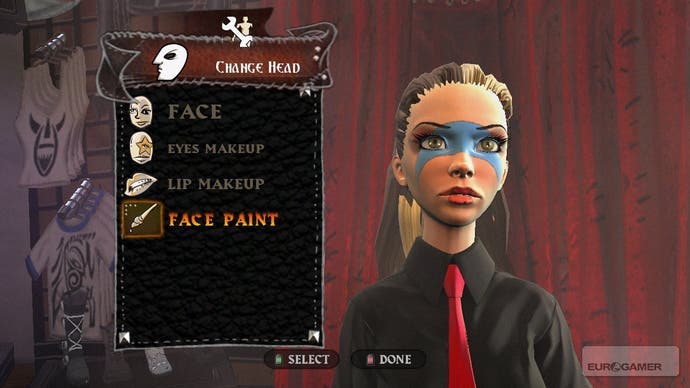
Like Guitar Hero III's excellent Les Paul, the new guitar also strums with a click, but there's a bit more resistance - a better implementation of the same approach taken with Rock Band's soft strum bar - while the whammy bar is longer for easier use, and a Star Power button gives players the option of palming for score multipliers rather than whipping the neck aloft. There are also new multi-part extended sustains, where you strum additional notes while keeping hold of others, building up chords. Rock Band's Bass Groove - a proper 'zone' feature for bassists - is an inevitable and much-missed absentee, but a purple horizontal line invites bassists to lay off the frets and play an open note to add a bit of variety.
As with Rock Band 12 months ago - or about five minutes ago in Europe - the drums are the most interesting element of Guitar Hero World Tour because they're the biggest novelty, and RedOctane has also outdone the Rock Band kit here with a five-pad set that includes two raised cymbal pads and a foot pedal made out of sterner stuff than its plywood counterpart. The rubberised, velocity-sensitive drums are more fun to play with and going back to the Rock Band ones afterwards is like being given a bicycle after a car. There's even a MIDI input at the back for add-ons.
In gameplay terms, it's a similar system to the guitars: the note charts show five lanes of descending symbols and as they cross the threshold at the bottom of the screen you strike the corresponding drum. When a horizontal line approaches, it's time to hit the pedal, and accented notes provide more points for hitting the pads harder. Having presumably been called before teacher, Neversoft includes support for the Rock Band drums, which lose one lane of input from the note charts to allow for fewer pads.
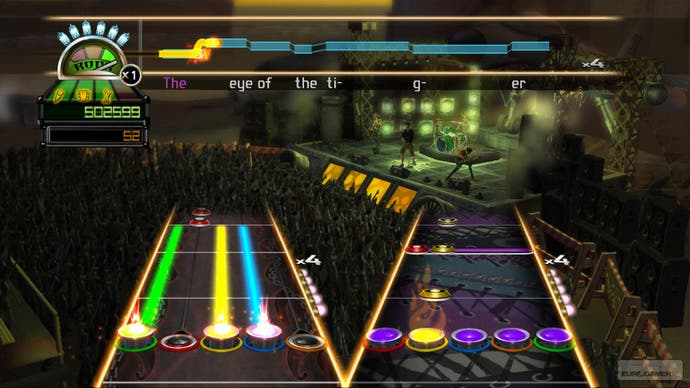
For vocalists, the USB microphone is wired, unlike the guitar or drum-set, and like every karaoke game ever you're supposed to match pitch and rhythm, allowing those with a limited vocal range to sing their way through tough songs in relative comfort. You can also choose between scrolling and static lyric sheets. Scrolling follows the pitch and timing for better singing, while static gives you longer to take in the words. The difficulty levels are as forgiving as they are in Rock Band, but you still wouldn't want to venture into a "Hard" rendition without a sense of the pitch, which remains more useful than actually knowing the words.
Playing together is much the same as Rock Band, with a crowded screen showing note charts for guitar, bass and drums in the middle while vocals scroll along the top. Able to reuse the Guitar Hero interface rather than having to build a legally new one, as Harmonix had to do, players respond to familiar bright, round icons on the note charts while the traditional needle pointer for band performance quality sits in the corner, also keeping track of accumulated Star Power. Icons denoting individual multipliers sit next to each note chart for easy reference at a glance.
Star Power, collected as ever by completing highlighted note sequences without error, can be activated by individuals, but multiple players can draw upon it at once. You could argue that this doesn't engender band unity the way Rock Band's everyone-at-the-same-time Overdrive move does, but you could argue back that the experience is shared enough by physical proximity. If the group plays well in unison, the game rewards the band note-streak, while good players are able to carry poor ones. That said, failed players can't be rescued as they can in Rock Band, leading to more incomplete songs.
Review | No Rest For the Wicked early access review - a shaky start, but there's potential
Review | Stellar Blade review - no thinking, just slashing
Review | Manor Lords early access review - beautiful foundations but missing important pieces
Review | Tales of Kenzera review: a compassionate Afro-futurist exploration of grief
Review | Eiyuden Chronicle: Hundred Heroes review - a Suikoden successor that plays things safe
Review | Life Eater review - an intriguingly uncomfortable game about abduction that chickens out a bit
Review | Harold Halibut review - sub-aquatic sci-fi adventure is a little too prog-rock
Review | Inkbound review - another stand out roguelike by the Monster Train team
Guitar Hero World Tour Review
That's one giant leap for a franchise; one small step for a genre.
By Aaron Thomas on November 3, 2008 at 5:18PM PST
As soon as Rock Band let you play guitar, bass, drums, and sing to your favorite music, it was clear the bar had been raised in the music-game genre. It wasn't long before Activision announced that the Guitar Hero series would follow suit. The result is a very entertaining game that doesn't break a whole lot of new ground. Guitar Hero World Tour's in-game music creation feature isn't as revolutionary as it could have been due to its convoluted interface, but thanks to a huge setlist of recognizable hits and cant-miss gameplay, World Tour is a great game and certainly a huge step forward for the franchise.
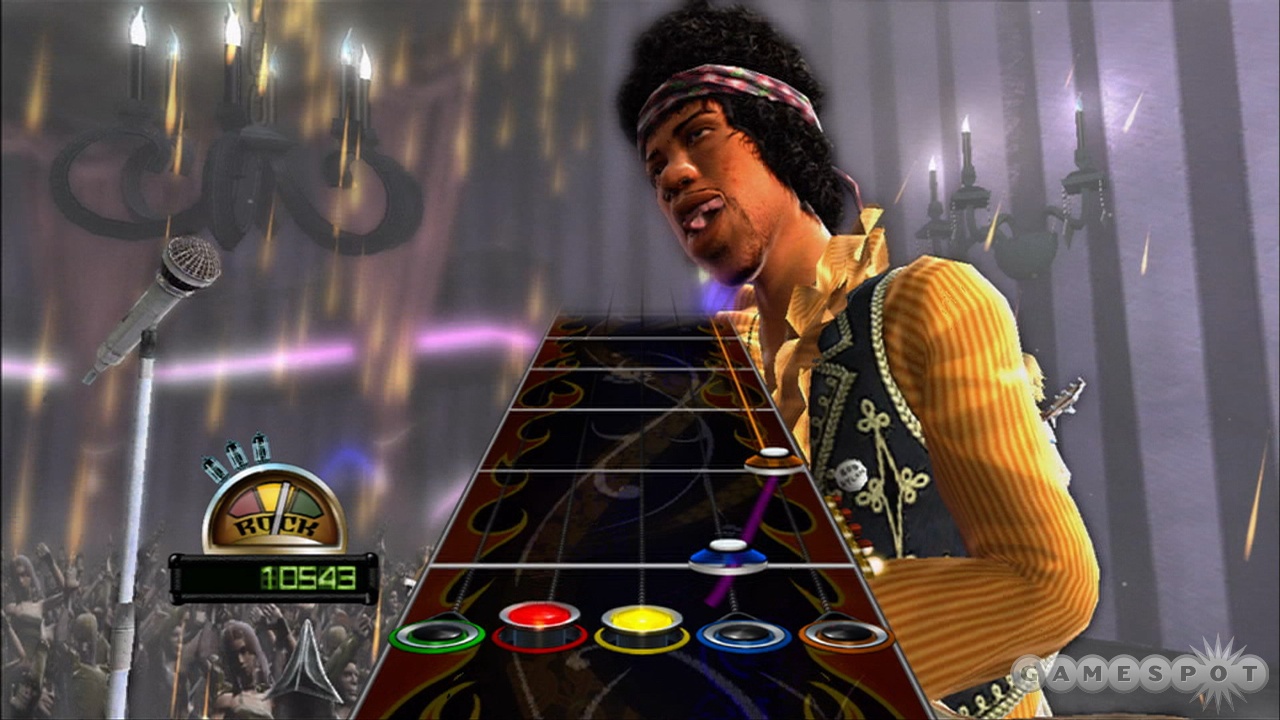
The most obvious difference between World Tour and previous Guitar Hero games is that you can now sing, play drums, play bass, or play guitar. You can play one instrument alone, perform as a band with a few friends, or even hop online and rock head-to-head or as some sort of Internet supergroup. The long-awaited ability to play as a "real" band in a Guitar Hero game improves what was previously an experience shared by one or two people on guitar and bass. Bickering over setlists; swapping instruments midset; getting sweaty and stinky from jumping around in a small room while your friend with the terrible voice gives it his or her all in "Livin' on a Prayer" as your neighbors bang on the wall...that's when Guitar Hero World Tour is at its best.
GH World Tour is available as an instrument bundle or as a standalone disc. If you don't buy the bundle, you can use guitars from previous games as well as peripherals from both iterations of Rock Band. The latter option might be your best bet given the less-than-stellar performance of the World Tour hardware over a week-and-a-half of play. The drums have several issues: Cymbals are either too sensitive or not sensitive enough, and the bass pedal is inconsistent as well. That's nothing compared to the problems that we've had with the guitars. The fret buttons began to stick after a day, and it wasn't long before the strum bar failed to accurately recognize input. The frets held up better on our second guitar, but the strum bar quickly failed on it as well. One nice thing about that guitar is that you can activate star power either by tilting your instrument or by simply pressing a new button below the strum bar with the palm of your hand. Just be careful not to press the poorly placed pause button while you're at it.
The big new feature in Guitar Hero World Tour is the music studio. It lets you create and share your own tunes, as well as download songs from others. Should you watch all of the tutorials and put in the time to learn the complicated yet robust program, you'll be able to produce some amazing results. The bad news is that you have to put in a lot of time and effort because it's incredibly difficult to make music creation a user-friendly experience on a console, but it's near impossible if you force people to use a fake guitar. To make matters worse, there's no way to add vocals or lyrics to your creations, so it's quite possible your song will sound just like the hundreds of thousands of bad MIDI songs that permeate the Web. That said, if you're unable to channel your inner John Lennon, you can still enjoy the fruits of the music studio via other people's work. Just a week after the game's release, there are already a number of impressive user-created efforts available for download.

World Tour has a Career mode, but it involves little more than playing sets of songs to earn money and unlock more songs. You have some control over what order you tackle the setlists and can personalize your rocker. You can even build custom instruments, but your career is linear and not all that interesting. However, it is pretty neat to see Jimi Hendrix stroll out on stage for "Purple Haze" (even if he does look a bit zombielike), and now that they don't feature any weird string-breaking gimmicks, the boss battles are actually enjoyable. The game includes more than 80 songs, all of which are master tracks from the original artists. The setlist covers a variety of styles and features a huge number of big-name artists. These include The Eagles, Metallica, Michael Jackson, Van Halen, Lenny Kravitz, Sting, Oasis, No Doubt, Nirvana, Coldplay, The Doors, Foo Fighters, Jimi Hendrix, and many more. It's an impressive collection of artists, and you're not often stuck playing some unknown song by these acts, either. You'll get to play "Beat It" rather than "Man in the Mirror." You also won't get stuck with some terrible Gary Sharone-era Van Halen; you'll get David Lee Roth and "Hot for Teacher." As is now the norm for the genre, World Tour includes a store where you can purchase new music. It should be noted that outside of the new Metallica album, none of the downloadable content from Guitar Hero 3 is compatible, which is a shame.
For the most part, World Tour looks and plays exactly as you'd expect, but there are a few things it does differently; some good, some bad. Musicians' animations have been improved, particularly with regards to vocalist's lips being in-synch with the lyrics. The ability to customize your rocker's pre-and-post song animation is also cool--especially when you've got him or her doing the robot after a good performance and smashing his or her guitar after a failed song. The vocals constantly track your pitch, leaving a trail behind that shows how your pitch has changed. This is extremely helpful when you're trying to sing the right notes and intervals at the start of a verse in a song with which you're unfamiliar. Bass players get a new challenge to deal with in the form of an open note, which is represented by a large bar that covers the entire width of the note highway. You might not think hitting the strum bar without pressing a fret would be noteworthy, but as any bass player will tell you, it makes the experience even more realistic. Last, but not least, the game gives you a quick countdown when returning from the pause menu, which gives you a fighting chance at hitting your first notes.
Those are the new mechanics that work well, but there are a few that aren't as useful. When playing drums, you must activate star power by hitting both cymbals at the same time. While hitting the cymbals isn't hard in and of itself, hitting them in rhythm so that you don't lose your consecutive note streak is extremely challenging. Unless you're a skilled percussionist, you're probably better off waiting until your streak ends on its own rather than trying to activate star power. Guitarists will have to deal with the most unique and not-so-useful mechanic. Anytime you see notes attached with a purple rope, you're able to move up to the touch-sensitive area above the normal fret buttons and play the notes by sliding across or tapping the pad. This lets you play the "wah-wah" part from "The Joker" with ease, you can play slap bass, and it's fun to act as if you're playing a keyboard in "Rebel Yell," but those are the exceptions. Generally, you'll find that using the touch-area results in missed notes because either it's not sensing your input properly or you're struggling to go from the fret buttons, up to the pad, and back. It's a neat idea, but it's executed poorly.
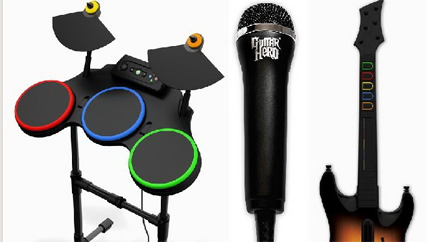
Guitar Hero World Tour is a huge leap forward for the Guitar Hero franchise. It's a blast to play with friends, the setlist is top-notch, and the music studio is a nice--albeit extremely complicated--addition. Although it's a great game, as well as a vast improvement over previous series entries, it doesn't do a whole lot that Rock Band and its sequel haven't already done (and in some cases, done better). With that in mind, if you really like Guitar Hero's setlist and you're interested (and patient enough) in creating your own music, pack your bags to head out on tour.
- Leave Blank
- Great setlist with more than 80 songs
- You can now sing and play bass, guitar, drums
- Lets you create, share, and download original music
- Some new additions don't enhance experience
- Doesn't do much that other, similar games haven't done
About the Author
Aaron Thomas
More gamespot reviews.
Use your keyboard!
Log in to comment
- PlayStation 3
- PlayStation 4
- PlayStation 5
- Xbox Series
- More Systems
what is the horizontal purple lines and how do i hit it?
Guitar hero: metallica, playstation 3 playstation 2 wii xbox 360, guitar hero: metallica (xbox 360).
- what is the horizontal purple lines and how do i hit it? LightEconomist2 - 2 years ago - report
Top Voted Answer
- The purple lines appear for 2 instruments: drums, and bass. Drums: Press on the kick pedal with your foot. Bass: Strum (or pull-off if glowing white) while not holding down any of the fret buttons. Derpytron84 - 2 years ago - report 1 0
- Actually for the drums, I think the lines may be orange for games other than GH World Tour. Derpytron84 - 2 years ago - report
More Questions from This Game
- Are online servers for this game still up? Tech Support X360 1 answer
- Can you play the game without a guitar on the wii? Tech Support WII 0 answers
- Is it any possibility to link Rock Band Drum set to Guitar Hero Metallica on Wii? Tech Support WII 0 answers
- What does preformence mode do in the game? Side Quest PS3 1 answer
GHWT: DE works best off of the following:
- OS: Windows 10 (64 bit)
- CPU: Intel Core i5 6th generation or AMD equivalent
- RAM: 4 GB or higher
- GPU: Dedicated GPU, NVIDIA GeForce GTX 900 or AMD equivalent
Take a peek through our helpful Getting Started guide for more information.
This guide should cover most problems that you may encounter when installing or trying to play the mod. Read on!
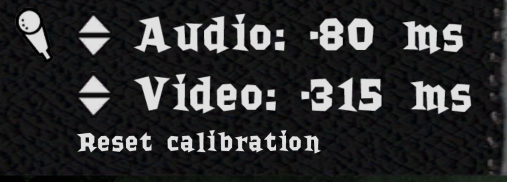
Mods go in the DATA/MODS directory.
Read the Installing Mods page on the Wiki for a complete guide on how to install characters, songs, and other modded content.
“I was standing in line at the bank when Dickey called: ‘Hey, listen – my guitar player just quit and the tour starts in a week. Do you want to do it?’” How I went from guitar journalist to Dickey Betts’ right-hand man
Guitar World’s Andy Aledort played over 250 shows around the globe with his hero. He traces his history with the late Allman Brothers Band icon, and shares his personal experience of working with the complex, generous guitar legend who once gave him one of Duane Allman’s slides
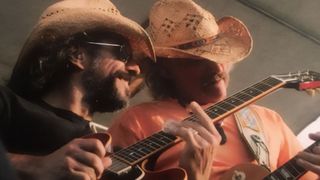
From 2005 to 2014, I had the honor and privilege of playing alongside Dickey Betts in his band, Great Southern. Sharing the stage with Dickey for a decade constitutes some of the greatest musical experiences of my life, and it was truly a blessing to get to know him and call him a friend.
Dickey was a giant, universally revered as one of the greatest guitarists of all time . He possessed a purely distinct signature style and sound that was uniquely his own, distinguished by an ingenious blend of blues, rock, country, Western swing and Appalachian string music, delivered with the touch, tone and technique of a true virtuoso.
As one of the founding members of the Allman Brothers Band, Dickey, via his phenomenal playing and brilliant songwriting, laid the foundation for what was at the time a new style of music to be known as Southern rock.
He and his co-guitarist, Duane Allman, weaved intricate harmonized guitar parts unlike any ever heard before; prime examples of these beautifully intricate harmonized lines are at the heart of songs such as Blue Sky , Revival , In Memory of Elizabeth Reed and many others. Betts’ impact on generations of guitarists, as well as all musicians and the broad spectrum of American music, is immeasurable.
During my 10 years as Dickey’s guitarist, we played upwards of 250 shows across the globe. We traversed the U.S. many times and traveled to Japan and performed in Germany, Poland and Spain on numerous occasions. As one might imagine, there’s a flood of great memories from all of the shows and events shared over the years. My journeys with Dickey Betts taught me more about performing, and about life, than all of the years leading up to that point.
Betts has long been one of my favorite guitarists. I fell in love with his playing from my initiation to the Allman Brothers Band’s music via their classic 1971 double live album, At Fillmore East .
As an aspiring 15-year-old guitarist at the time, I remember hearing Statesboro Blues on a New York FM radio station, kicked off by the classic spoken introduction, “Ok, the Allman Brothers Band!” and Duane Allman’s laser-like slide guitar playing.
Get The Pick Newsletter
All the latest guitar news, interviews, lessons, reviews, deals and more, direct to your inbox!
I had just started to play slide, and when I heard Statesboro , it inspired me to sit down in earnest to get it together, doing my best to learn every one of Duane’s slide solos, along with every single Duane and Dickey solo on the entire album. 30 years later, this dedicated study would pay off in ways I never could’ve imagined.

As a longtime writer for guitar magazines, I’d had the opportunity to interview, play with and become friends with many of my guitar heroes, including Johnny Winter, Buddy Guy, B.B. King, Jeff Beck, Albert King, John McLaughlin and others. As of 2001, Dickey Betts had not been one of them.
During the ’90s, Allman Brothers’ guitarist Warren Haynes had become a friend, and throughout that time I found myself backstage at many Allman Brothers shows at the Beacon Theatre in New York City.
There were a handful of times when I was within a few feet of Dickey; he’d always be sitting in a chair off the side of the stage, apart from everyone else, most definitely “in his own space.” His vibe was that he wanted to be left alone, and I respected the impression he gave.
In 2000, Dickey was unceremoniously “released” – fired – from the Allman Brothers Band. Stories abounded on both sides with a lot of negative statements made. Guitar World Editor-in-Chief Brad Tolinski thought it would be a good idea to offer Dickey a monthly column in the magazine, as it would afford him the opportunity to speak directly to his many fans around the world. I began working with Dickey on his column, called True Grit , which ultimately ran for more than a year and a half.
The lessons were a big hit with the readers, as each month he’d use the space to teach and discuss his most beloved songs, such as In Memory of Elizabeth Reed , Blue Sky , Jessica and Ramblin’ Man . Readers could see how deep-thinking and eloquent Betts was, as he spoke at length about the roots of his playing, which began at the age of five, when he played guitar alongside his violin-playing father and uncles.
The family’s musical heritage originated from Prince Edward Sound in Nova Scotia, and this very distinct style can be found in indigenous Acadian recordings from more than 100 years ago. Elements of the unique melodic nature of this music served to lay the groundwork for Dickey’s original and beautifully melodic soloing style on the guitar.
“An important element in the formation of my style is that my dad was a fiddle player, and I grew up surrounded by all of those great bluegrass fiddle melodies,” Dickey said.
“My dad was very into precision; he was a cabinet maker, and every nail had to be driven just right. He was the same way about music: the fiddle had to be tuned perfectly, and he played with the same precise approach.
One day, I said, “Dickey, it would be great to sit in with you some time if the opportunity arises…” He said, “Any show you can make, call my stage manager Mike, and he will make sure there is a half-stack Marshall waiting for you”
“All of those beautiful Irish folk melodies of the fiddle had an impact on me early on, which I didn’t even realize until I started trying to find my own voice on the guitar. The strong sense of melody I inherited from him had been deeply instilled in me.
“That’s when I began to search for a strong sense of melody within the blues form, which I think is a good overall characterization of my style. One of the best examples of this influence coming to the fore is Jessica .”
In putting the articles together, Dickey and I would speak at length on the phone. One day, I said to him, “Dickey, it would be great to sit in with you some time if the opportunity arises.” His response was unexpected; he said, “Any show you can make, call my stage manager Mike, and he will make sure there is a half-stack Marshall waiting for you.” No-one had ever made such a generous offer to me.
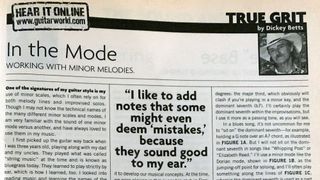
For the next three years, if Dickey had a show within 100 miles, I made sure I was there. Between 2002 and 2005, I sat in with Dickey and the band more than 20 times.
For most people, Betts was a bit of an enigma. His reputation as a hell raiser was well earned, and there’s no way anyone could know what he was like on a personal level. He was definitely mercurial, but he was also one of the sweetest and most generous people you could ever meet. And his sense of humor was tremendous.
In 2003, before I joined the band, he invited me down to his house to celebrate his birthday with him and his family. It was a nice gathering, with one of his daughters and his grandchildren; I was the only non-family member there.
It was a tall task to learn all of the intricate harmonized guitar parts for Dickey's entire three-hour show, and I had about two days to do it
At one point I went outside to call my wife, and within a few minutes, the door opened and there was Dickey with a plate and a big piece of birthday cake. He said, “I was looking for you! Don’t you want some of my cake?”
One morning in 2005, while I was standing in line at the bank, Dickey called and said, “Hey, listen – my guitar player just quit and the tour starts in a week. Do you want to do it?” At that time I had a full-time job with Guitar World , writing for five different magazines, plus two young kids at home. So I said, “Yes, definitely! When do you want me to come down?” He said, “Right now!”
It was a tall task to learn all of the intricate harmonized guitar parts for Dickey's entire three-hour show, and I had about two days to do it. His sets included some of his most difficult material, such as High Falls , Nobody Knows , True Gravity , Jessica , Nothing You Can Do , Revival and so many others – almost all of the material from the Allman Brothers records as well as the Great Southern records and new songs, too. I transcribed reams of charts and brought them with me, and from the very first rehearsal, we were off to the races.
At our very first show, a private event at B.B. King’s Blues Club & Grill in New York City, I went up onstage before sound check to plug in and get the sound together. Dickey came out, stood next to me, plugged in and said, “Let’s play High Falls together.”
As we started to play the opening harmonized lines, he stopped and said, “You should play the parts a little more delicately. Think of our guitars harmonizing in the same way that the Everly Brothers sing.” It was such a beautiful way to describe the sound he was looking for, and I knew immediately what he meant. That one piece of advice changed the entire way I looked at playing harmonized parts with him for all of the songs.
I’ve been asked many times what it was like to work with Dickey. He was a great artist, and as such was very sensitive to every aspect of the music and the contributions of each member of the band.
He could be very impressionistic in his descriptions of what he was looking for. For example, for the last section of the final harmonized lines in Jessica , he said, “For this part, imagine leaves falling gently in the breeze, drifting back and forth as they drop down from the sky.” It was such a beautifully clear image, such a great mindset to have, and we all understood the nature of the sound he wanted.
On the first tour, we spent a lot of time sitting together on the bus, and he would talk about his feelings regarding leaving the Allman Brothers Band. He often became very emotional about it.
The music of the band he helped create, and the relationship between the band and the audience, meant everything in the world to him. There was a lot of frustration.
But he would never say anything negative about anyone in the band. He always referred to Gregg Allman as “Gregory,” and he would say, “Gregory is one of the greatest singers I have ever heard. The man has a golden voice.”
I used Duane Allman’s slide for every gig for the next six years
In 2011, we had just returned from a Rock Legends cruise and were sitting in his music room – it was just Dickey, his guitar tech Carlos Rodriquez and me. We were talking about songs to add to the set, and I said, “People always ask for Pony Boy ; it’s such a great tune.” Dickey said, “Oh, I played that on an acoustic resonator guitar , and I don’t think I even remember how to play it.”
He then picked up a resonator guitar that was next to him and proceeded to play the intricate slide guitar part of Pony Boy … perfectly . It appeared to be absolutely effortless. Carlos and I had our jaws on the ground.
He then looked at me and said, “I gave you one of Duane’s slides, right?” I said, “No, you did not!” He walked to the other room and within a few minutes came back holding out a glass Coricidin bottle.
He said, “I could only find one — here you go.” I said, ”Don’t give it to me if you only have one!” He said, “There are some others here somewhere. You don’t have to use it if you don’t want to.” I said, “Yes, I most definitely want to.” I used Duane Allman’s slide for every gig for the next six years.
Dickey was a complex person. He was very passionate about music and could be intense about what he wanted and expected from the band. Dickey set the bar very high and led by example. These are the things that made him who he was and made him such a great bandleader. He wanted and expected everyone to play their best, even better than they thought they could. The result was that everyone’s level of musicianship grew by leaps and bounds.
I am forever indebted to Dickey Betts for the opportunity to play with him and spend time with him. He blessed the world with his incredible music, and his great legacy will be celebrated for decades to come.
Thank you for reading 5 articles this month**
Join now for unlimited access
US pricing $3.99 per month or $39.00 per year
UK pricing £2.99 per month or £29.00 per year
Europe pricing €3.49 per month or €34.00 per year
*Read 5 free articles per month without a subscription
Prices from £2.99/$3.99/€3.49
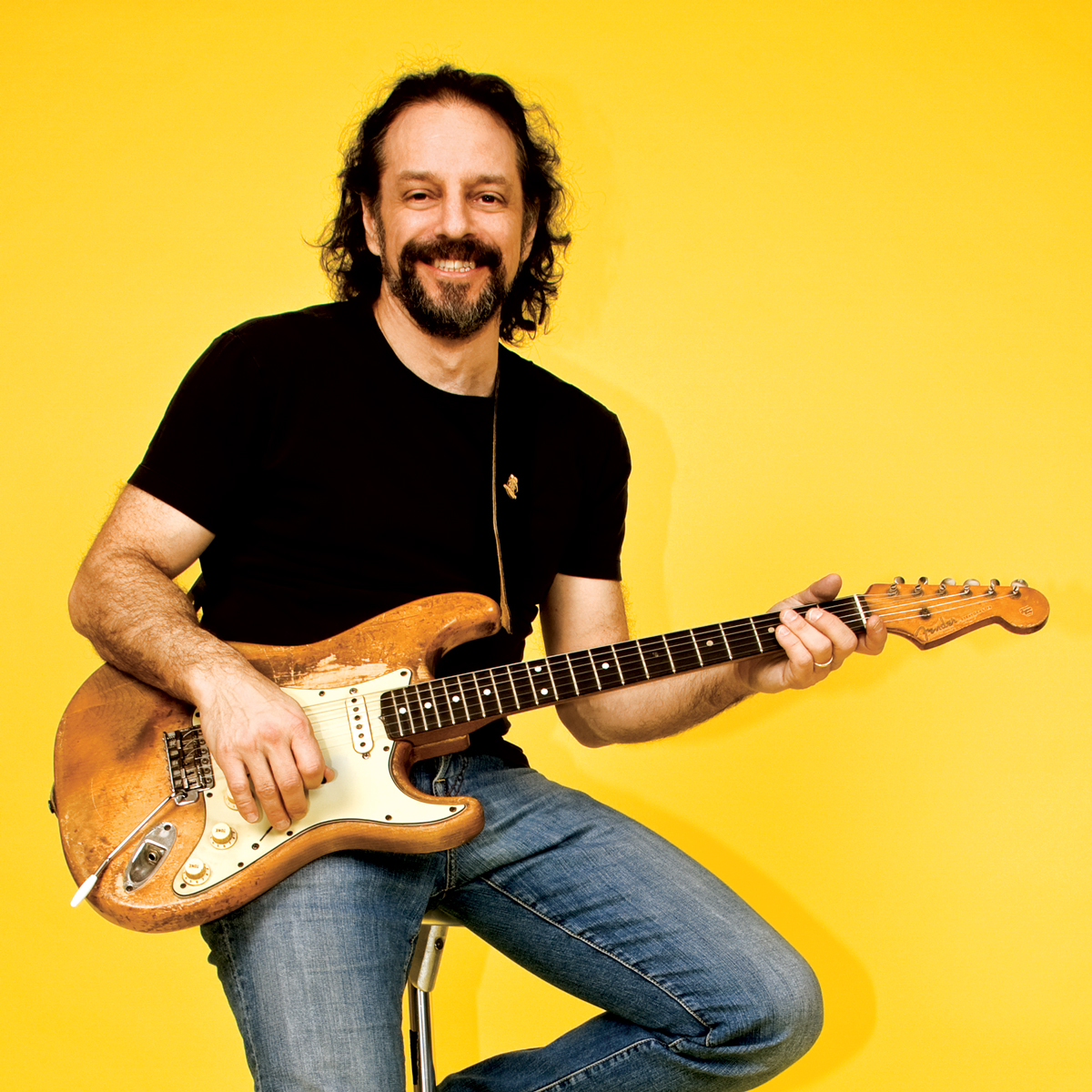
Guitar World Associate Editor Andy Aledort is recognized worldwide for his vast contributions to guitar instruction, via his many best-selling instructional DVDs, transcription books and online lessons. Andy is a regular contributor to Guitar World and Truefire, and has toured with Dickey Betts of the Allman Brothers, as well as participating in several Jimi Hendrix Tribute Tours.
“In the ’80s, I was very much into playing fast and wanting to be the best. Later on I realized it was just a waste of time”: Europe’s John Norum on the one guitar he kept from the Final Countdown era, and what he learned from Don Dokken
“Sometimes I make the bassline too complex and too noodly, but Thom is good at putting the brakes on that”: How Colin Greenwood came up with his deceptive stop-start bassline on Radiohead’s Airbag
“When I recorded with Jason Becker, he was still able to speak… he articulated exactly what he wanted, down to every pinch harmonic, vibrato and out-of-tune note”: Shrapnel veteran Michael Lee Firkins reflects on the final days of shred
Most Popular

IMAGES
VIDEO
COMMENTS
Ohhhhhhhhh purple lines connecting the notes. I get you now. When a series of notes are connected by a purple line, you can play it all using the touch strip on the World Tour guitar which you don't have, so don't worry about it. Boards. Guitar Hero World Tour.
In Guitar Hero: World Tour, I've noticed there are two different kinds of notes that are designed to be used specifically with the slider touch pad on the guitar. Both types of notes are hollow-ish see-through, but sometimes there is kind of a purple string attaching strings of notes together and sometimes not.
Playlist:https://www.youtube.com/playlist?list=PLhqQblXS9-ERn779BtyMZ1NLbDKl2LcBbAny Ads On This Video Are NOT Monetized By Me.
Guitar Hero World Tour (initially referred to as Guitar Hero IV or Guitar Hero IV: World Tour) is a music video game developed by Neversoft and published by RedOctane and Activision. It is the fourth main entry in the Guitar Hero series. The game was launched in North America in October 26, 2008 for the PlayStation 2, PlayStation 3, Wii, and Xbox 360 consoles, and a month later for Europe and ...
So a year later, Neversoft is back with Guitar Hero World Tour and this time the drums and mic are along for the ride. ... It will come down the note line as a straight purple line just like a bass drum line and in essence acts like a sixth note. While nothing really Earth shattering, it is nice for the bass to get a little different gameplay ...
Guitar Hero World Tour is a 2008 rhythm game developed by Neversoft and published by Activision.It is the fourth main installment and the sixth overall installment in the Guitar Hero series.The game was launched in North America in October 2008 for the PlayStation 2, PlayStation 3, Wii, and Xbox 360 consoles, and a month later for Europe and Australia. A version of World Tour for Microsoft ...
Guitar Hero World Tour Guitar. Now that you've got the frets down, we'll focus on the strum bar, which is near the center of the guitar's body. Every time you hit a note, you'll need to strum that ...
The Rock Band series is now two games and many dozens of downloadable songs deep, and developer Harmonix, having abandoned the Guitar Hero series it designed and launched to work on Rock Band with ...
A somewhat similar mode to Music Studio exists only on the Wii version of World Tour. Known as Mii Freestyle, this mode presents a chance for a guitarist and drummer to jam alongside one another ...
Guitar Hero World Tour will be released on October 26th, and it promises to deliver the rock-god goods with a whole new host of songs by the likes of Jimi Hendrix, The Doors, Van Halen, Metallica ...
Guitar Hero World Tour is a huge leap forward for the Guitar Hero franchise. It's a blast to play with friends, the setlist is top-notch, and the music studio is a nice--albeit extremely ...
Purple Haze: The Jimi Hendrix Experience: AT&T Park Encore (San Franscico) ... Guitar Hero World Tour. Vicarious Visions Oct 26, 2008 +2. Rate this game. Related Guides. Overview ...
The entire setlist to the game Guitar Hero: World Tour.
Purple Haze (Live) - The Jimi Hendrix ExperienceTesting the waters with this. I recently learned that when you submit a copyright dispute, after 48 hours th...
The purple lines appear for 2 instruments: drums, and bass. Drums: Press on the kick pedal with your foot. Bass: Strum (or pull-off if glowing white) while not holding down any of the fret buttons.
The guitar interface remains relatively unchanged in World Tour. As with previous Guitar Hero titles, the guitar and bass player must hold down the correct fret button (s) on the controller while also strumming in time with the notes as they scroll on-screen. A minor addition to the the guitar gameplay is the ability to play notes while holding ...
Guitar Hero World Tour is the fourth major release in the Guitar Hero series of music video games, a series that has sold over 24 million units and earned more than $1.6 billion in retail sales. The game was released in October 2008 for the PlayStation 2, PlayStation 3, Wii, and Xbox 360 game consoles in North America, and a month later for PAL regions.
"Purple Haze (Live)" by The Jimi Hendrix Experience. As featured in Guitar Hero: World Tour.This is only meant to show the chart. THIS IS NOT MEANT TO SHOW S...
48 great records cherry-picked from Guitar Hero 1 and 2, Encore: Rocks the 80's, Legends of Rock, and Aerosmith await you in the Smash Hits setlist! Whether you miss the ridiculous difficulty of Through The Fire and Flames, the iconic galloping guitars of The Trooper, or even want it to start Raining Blood, there is at least more than one song for you to have fun with here!
Video download for use in Clone Herohttps://drive.google.com/drive/folders/159tV_GZY_oXC9mIAmuez45K2Jd6h1aq2?usp=share_linkRecorded on Xbox 360 with an Elgat...
He and his co-guitarist, Duane Allman, weaved intricate harmonized guitar parts unlike any ever heard before; prime examples of these beautifully intricate harmonized lines are at the heart of songs such as Blue Sky, Revival, In Memory of Elizabeth Reed and many others. Betts' impact on generations of guitarists, as well as all musicians and the broad spectrum of American music, is immeasurable.
About Press Copyright Contact us Creators Advertise Developers Terms Privacy Policy & Safety How YouTube works Test new features NFL Sunday Ticket Press Copyright ...